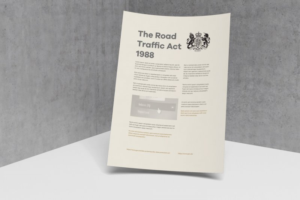Related Courses
The Road Traffic Act 1988 applies to all vehicles and drivers within the UK as it essentially covers the correct and appropriate use of vehicles on the road in the UK. Health and safety in the UK is of the utmost importance and relevant legislation extends to driving at work, particularly within the Road Traffic Act 1988. To ensure your employees are conducting driving at work safely and appropriately, the Road Traffic Act 1988 is an essential piece of legislation to learn about.
What are the clauses in the Road Traffic Act 1988?
There are six essential sections to the Road Traffic Act 1988, set out in the following way:
Section One: Road Safety Provisions
This section focuses upon the safety provisions involved when driving on UK roads, such as:
– No driving whilst under the influence of alcohol or drugs.
– Wearing seat belts or helmets whilst driving a motorbike.
– No stopping in dangerous areas, such as on a verge.
– Awareness of pedestrians and driving safely with pedestrians in mind.
Section Two: Use of Vehicles and Equipment
This section focuses upon the design and construction of vehicles and their respective safety features, such as:
– Testing of the vehicle on the roads to ensure it is safe to drive.
– Ensuring horse-drawn vehicles are safely constructed.

Section Three: Licensing of Drivers of Vehicles
This section focuses upon what is required to hold a license to a vehicle, such as:
– Whether an individual has passed all of the relevant tests to own a vehicle.
– Whether an individual deserves to be disqualified from holding a licence to a vehicle.
Section Four: Heavy Goods Vehicles
To drive a heavy goods vehicle, it is required for an individual l to hold a HGV licence.
– To hold a HGV license, the granting, duration and revocation of a HGV licence from an individual is taken into careful account.
Section Five: Driving Instruction
This includes:
– Registration to drive.
– Licence to drive.
– The passing of relevant driving tests.
Section Six: Third-Party Liabilities
If a third party is going to be driving a particular vehicle, insurance and security for this third party must be ensured.
Who is Responsible for Enforcing the Road Traffic Act 1988?
Essentially, the police are responsible for enforcing the Road Traffic Act 1988. Therefore, if an individual in the UK breaches the Road Traffic Act 1988, then they will be subject to the enforcement regulations of the police division in that specific area.
The Road Traffic Act 1988 has received reform and re-evaluation in preceding years, as the situations on UK roads have changed drastically considering the increased number of vehicles on the roads, as well as the number of expanding roads. For example, in December 2018 drivers have been warned about potential upcoming consequences which might be incorporated into the Road Traffic Act 1988 regarding splashing pedestrians by driving through large puddles. The Road Traffic Act 1988 already states that it is an offence for motorists to ‘drive without reasonable consideration for other persons’. It has been suggested that motorists responsible for splashing pedestrians during heavy rain could face up to a maximum of £5,000 and nine points on their licence.
With the Road Traffic Act 1988 undergoing constant reform and analysis, it is important for employers and employees driving at work to stay up to date with the relevant provisions. Consequently, training and knowledge of the Road Traffic Act 1988 is particularly essential for those driving at work.


